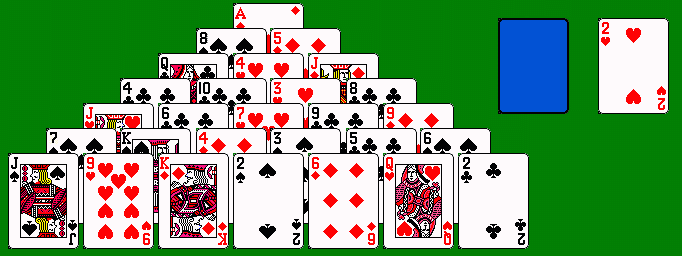
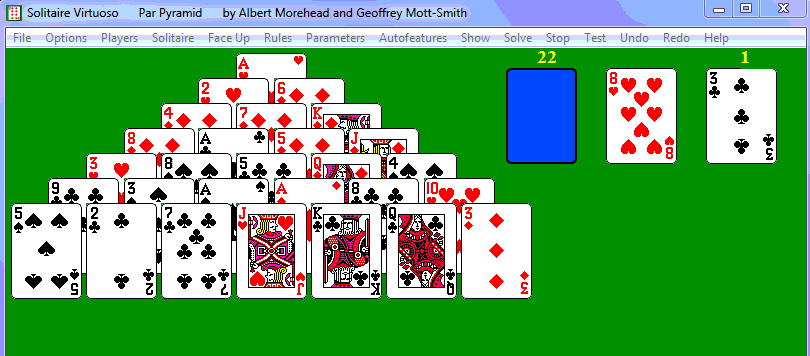
A Brief History of Pyramid
Originally an entirely different game went by the name The Pyramid: a forerunner of Carpet with a carpet of 15 cards dealt in a triangular arrangement without overlapping. This can be found as late as 1964, in Walter B. Gibson's How To Win At Solitaire. The modern game of Pyramid is almost certainly an American invention: it started appearing in various books under different names, while including the older game under its original title. Dean Bryden's 1927 Fun With Cards might be the first appearance of the modern version of Pyramid, under the title Elizabeth's Solitaire; he requires only the pyramid to be cleared, and gives a sample deal move by move. Johnson and Pope's 1928 book 30 Games of Solitaire may be the first book to include the modern Pyramid under its current name: they allow only one deal, but count it as a win to clear the pyramid, claiming a win rate of about 1 in 50. George A. Bonventure's 1930 Games of Solitaire includes it as The Tower of Twenty-Eight; he also allows only requires the pyramid to be cleared, but allows the waste to be redealt once. Helen L. Coops' 1939 book 100 Games of Solitaire also uses Tower of Twenty Eight (she drops the article from all her names, which is the modern practice), including it among games like Baroness. She allows no redeal of the waste, and requires all 52 cards to be discarded. Coops, like Bryden and Bonaventure, includes the older Pyramid; she also gives Pike's Peak as an alternate title, and lists The Carpet as a variant. [I suggest that Pike's Peak might be adopted as the standard name for the Carpet forerunner, as Pyramid now refers to the modern game we describe here. Pike's Peak was probably coined by Benjamin Newton, who borrowed games from Dick's Games of Patience for a book in the 1880's, renaming them all.] Pyramid appears under its modern name again in Games Digest in March 1938, where the author suggests it is next to impossible, and calls twelve cards left (counting both pyramid and waste) a successful result. After the publication of Morehead and Mott-Smith's The Complete Book of Solitaire and Patience Games in 1949 (which also saw the debut of Par Pyramid), Pyramid became well-established as a part of the standard repertoire of solitaire games, at least in the United States. Several sources cite Pile of Twenty-Eight as an alternate name, but I have not yet found a source which uses that as the primary name.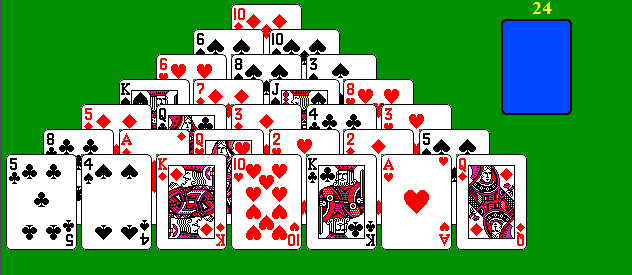
Tutenkhamen's Curse, or Pyramid
Puzzlements
(Why Pyramid Must Have The Top of The
Stock Available)
In 1990, Microsoft released the second of its Windows
Entertainment Packs, which
contained two card solitaires. The first of these was FreeCell, which
became a worldwide
phenomenon. The second was a variant of Pyramid called Tut's Tomb,
which did not. Tut's Tomb features (in one variant) a three-at-a-time
deal
from the stock to a
wastepile (lifted from the game Demon). [The alternate version, where
the stock is
dealt one card at a time without a redeal, is pretty well hopeless.].
The top of the stock
is not available, and the top of the waste can only be matched with an uncovered card from
the pyramid. The object of the game is to clear the pyramid of 28 cards
only, and while the
game is playable (i.e. it can be won occasionally), it is much less
interesting than most
Pyramid variants where all 52 cards must be discarded -- the skill in
playing Pyramid lies
in knowing what matches to make and which to pass up, and when to match
stock-to-waste and
when to match within the pyramid. Tut's Tomb allows overlap discards: a card in the
pyramid can be
matched with a card directly underneath it if that
card is not covered by
any other card. This helps somewhat, as we have seen earlier.
In some versions of the game, the object is to discard all 52 cards. What does this mean? Since every card from the stock of 24 (except kings) must be matched with a card from the pyramid of 28, it means that if all four kings are on the pyramid, there can be no pyramid-to-pyramid matches. Each king in the stock leaves room for one pyramid-to-pyramid match. Since most pyramids require a few matches within the pyramid to unblock troublesome ranks, this makes breaking down the pyramid extremely difficult. [Some computer versions of Pyramid make a different mistake, automatically discarding both cards (if they are complementary) when the top of the stock is placed on the waste to make room for a new stock card. Frequently one needs such a pair to break up a pair in the pyramid, especially where one is covering the other. See below for some solver data on how much of a difference this makes.]
But the situation is worse than that. Since
stock-to-waste matches are not
possible, the stock cannot contain more than four of any pair
of complementary
ranks (e.g. if there are 2 fives and 3 eights in the stock,
there will be no way
to discard the last one of each). Some of the pairs may have less than
four, the combined
shortfall being the same as the number of kings in the stock. What are
the odds of the
stock containing a suitable combination of ranks? I did a combinatorial
calculation (some
mathematically inclined reader may care to confirm this) showing that
5.547 percent of the
deals are acceptable -- a computer simulation of two million deals also
gave a figure
slightly above 5.5 percent. This means that if you cannot pair up
within the stock, you
can win at Pyramid 5-1/2 percent of the time if any
card from the stock
can be matched with any complementary card from the
pyramid regardless of
its location. Since the pyramid's shape makes cards available only
gradually (and we now know that about a third of pyramids are inherently blocked), and the
three-at-a-time deal makes matters worse, I can't imagine the win rate
being more than
about half a percent, and perhaps much less. And that win rate assumes
that the player
knows that the number of pyramid-to-pyramid matches is limited by the
number of kings in
the stock.

An impossible deal: If the top
of
the stock is not available to be matched with
the top of the waste, this Pyramid deal (screen shot from the Solitaire
Laboratory
program) cannot be won. There are two queens and three aces
in the stock, and
when three queen-ace matches have been made between the stock and
pyramid, there will be
one queen and one ace left in the stock and no way to discard them.
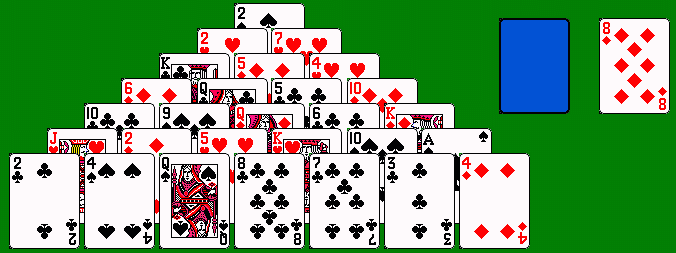
A possible deal: There is one king in the stock, thus 23 non-kings in the stock and 25 in the pyramid. One pyramid-to-pyramid match will be possible, which must be a jack-two match, specifically the jack of hearts and two of diamonds (the only two which is neither covers nor is covered by the jack). Such deals occur infrequently, and most have three or four kings in the stock. All other matches must be stock-to-pyramid.
When King Tut (modeled after the original Tut's Tomb) first appeared in Pretty Good Solitaire in 2001, the rules specified that all 52 cards must be discarded, and yet the Top Scores page listed 42 wins out of 408 tries. I suspect that some people were submitting doctored stats (interestingly, neither of the players who at that time had played enough games to be listed individually had won even once.) BVS Solitaire Collection's top score pages do not appear to have the same game, so I cannot compare its stats. King Tut's rules were later modified to require only the pyramid to be cleared. I still don't consider it to be a good game (much better is the three-deal Par Pyramid, with one card at a time dealt and the top of the stock available); I consider the three-at-a-time deal to be an overused mechanism which doesn't work well in most games, including Pyramid.
Does anyone out there have a fully winnable deal of King Tut (i.e. a deal number which can definitely be won by discarding all 52 cards)? I'm curious to know if there is anything wrong with my analysis.
The same mistake can be found in a number of other
computer versions of
Pyramid. Well-written books are explicit in allowing the top of
the waste to be matched with the next card dealt from the stock.

With all of the Pyramid variants in mind, I had the idea around 1996 to turn Pyramid into a completely open solitaire (one in which all of the cards are dealt face up at the start of the game) like FreeCell; such games are usually very skillful and puzzle-like. I tried a number of different tableaux; my original idea was four rows of six columns each below the pyramid, but this blocked too frequently. I also originally tried an upside-down pyramid, but the need to uncover the first few cards dominates the game and the latter part of the game is anticlimactic. Experimentation proved that three rows of eight cards (as in the picture below) worked best. I called the game Giza, after the location of the great Egyptian pyramid. Several hundred games suggested that the win rate is at least 1 in 3 with careful play, although many of the wins are very difficult and 1 in 4 is a reasonable goal. I wrote a computer version in 1997, and the game was first published in 1998. Other computer versions of the game for Windows can be found in Boris Sandberg's package BVS Solitaire Collection, Thomas Warfield's Pretty Good Solitaire, and Michael McCulloch's Solitaire Plus.
Mark Masten has analyzed Giza with his solver, dealing
10 million deals. The solver won 3,653,287 deals under the
standard rules (so the win rate is above 36%), and 5,928,825 with
overlap discards permitted in both the pyramid and tableau
columns. You are of course free to play whichever version you
prefer. You can even try the much harder six-column
game: the solver won 180,527 out of a million deals with standard
rules, and 384,911 with overlap discards.
Here are some difficult Giza problems I have found to date; the first is number 2112 in Solitaire Virtuoso. Any uncovered king, or any two uncovered cards adding to 13, may be removed (e.g. the four of diamonds may be removed along with either the nine of diamonds or the nine of hearts). No overlap discards are allowed in these problems: a card may not be removed along with a card it is covering (the queen of clubs cannot be removed along with the ace of diamonds). Can you discard all 52 cards?
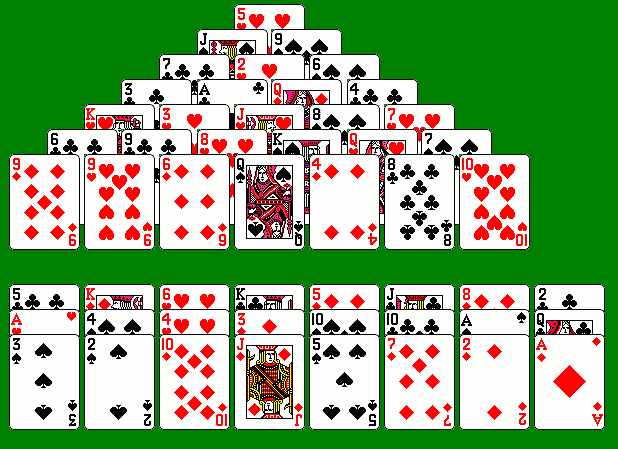
Here is number 15849 (solution):
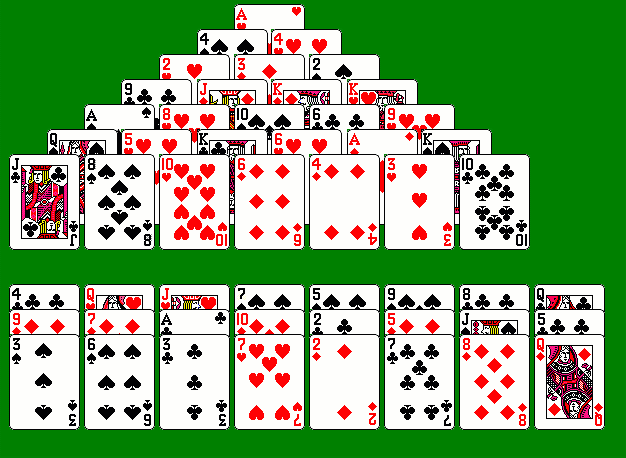
And here is number 50832 (solution):
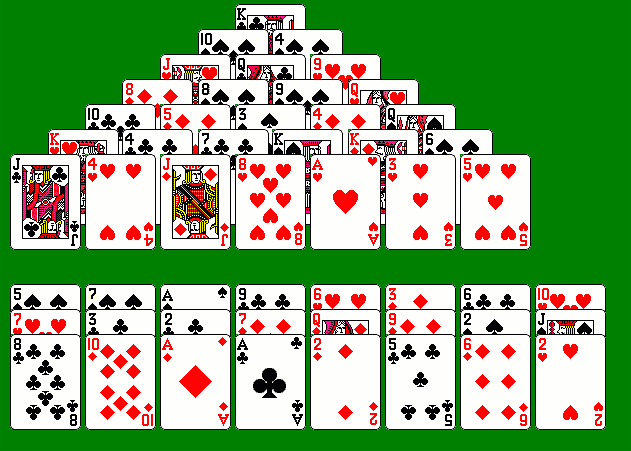
Appendix
Blocked pyramids of different sizes
Rows Overlap Wins Simple Adjusted Bouquet
Discard?
Blocks Win Rate
5
Yes 99639563 206435
99.85 37
No 98625648 459637 99.08
6
Yes 96923906 1501149
98.40 31
No 91893246 2592145 94.34
7
Yes 83151588 7167001
89.57 24
No 66865010 10659494 74.84
8
Yes 38349300
25275626
51.32 16
No 16303005 33593656 24.55
9
Yes 1279299
63905021
3.54 7
No 71531
75562119 0.29
This table
gives the number of wins, out of a sample of 100 million deals, with
each size of pyramid from 5 to 9 rows, with and without overlap
discards. Any cards remaining after the pyramid is dealt
form an open bouquet (from 37 cards in the 5-pyramid to just 7 in the
9-pyramid). Also listed are the number of deals in which a
card is blocked by all four of its complementary rank, and the adjusted
win rate if these deals are excluded by a computer program (or by
visual inspection by a player, who may then choose to skip the deal
without playing a card).
Solution to the solver example

The solver starts by discarding the KC and the 9H/4C (the solver wanted to expose 6S early, though discarding 9C/4C
would work as well). After dealing the first two
stock cards, it takes the pyramid 3C off with the TC. Already the
automatic stock-waste discard would have lost: the 3S is going to take
off the TS at the finish. You can actually start to see some of
the program's logic: it plans to set up a set of discards at the finish
with the first several waste cards and the last several pyramid cards,
working backwards through the waste. The next three stock cards
don't play with available cards, but match up perfectly with the
pyramid (5H/8D, 8C/5C,
QS/AC), so the solver does not discard 5H/8C. Now the 7H is dealt
and takes the 6S with it (the solver's reason
for discarding the 9H instead of the 9C, although it doesn't matter in
the end since a four comes next in the stock). The 4D takes off
the
9C, freeing the KD to be discarded alone. The 8S doesn't play,
but is earmarked for the 5S. At this point, it passes up
some possible pyramid plays, instead discarding the JS/2C, and dealing
five more stock cards, finally removing the 2D/JC. This seems
counterintuitive, but the program knows the order of the stock cards
and wants to match them in the correct order with the pyramid.
Now it takes off QH/AH and 4H/9D. AS/QC is no longer legal, since both
were already in the waste. Instead it takes off AS/QD and 7S/6H.
The two threes coming next in the stock take off the two tens on the
pyramid in either order, then JH/2H, followed by the two stock
kings.

At this point there are six cards left in the stock and nine on
the pyramid, and the solver can visualize the finish. The 4S will
take off the 9S, and there will be three stock-waste discards (the only
three in the entire solution), leaving the rest of the waste (in
reverse order) to take off the pyramid cards (with one pyramid-pyramid
discard interpolated). 7C is skipped (6D is earmarked for 7D),
then the next two cards (8H/5D) are discarded -- this is the first
stock-waste discard the solver has made. Now the 4S takes off the
9S, and the 6C/7C becomes the second stock-waste match. The last
stock card, the AD, takes off the QC in the waste, and the rest follows
easily: 7D/6D, 8S/5S, 2S/JD (both in the pyramid), QS/AC, 8C/5C, 5H/8D,
and 3S/TS. [When the solver was given the same deal with overlap
discards allowed, it played the same solution, except that it made the
early 5H/8C stock-waste match and took 5C/8D as an overlap discard.]
This article is copyright ©2024 by Michael Keller. All rights reserved. This file was revised on June 14, 2024.